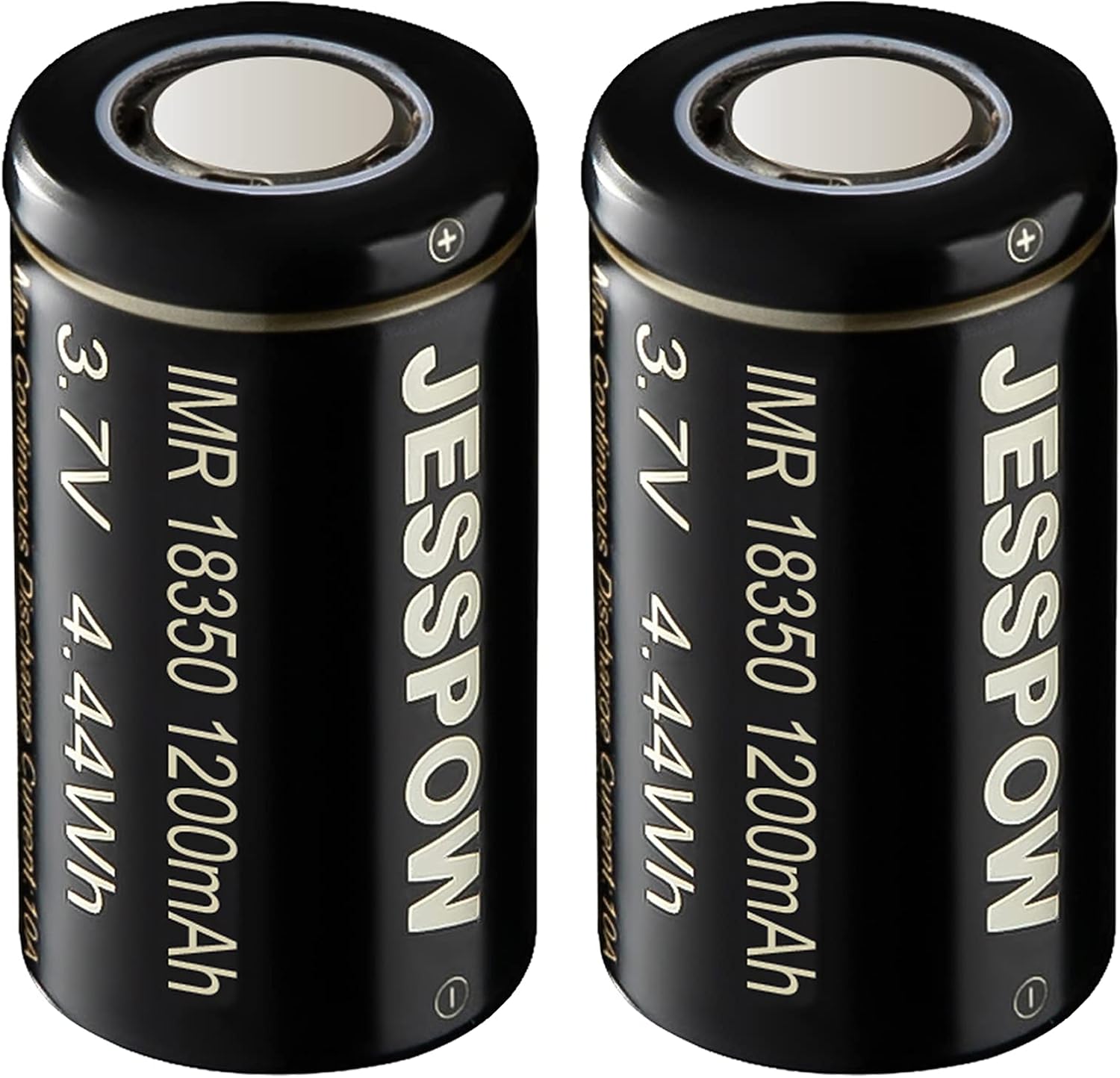The main advantages of using 18350 rechargeable batteries include their compact size, high energy density, and ability to deliver high discharge rates. They are commonly used in vaping devices and flashlights due to their lightweight design and reliable performance.
In the realm of portable power solutions, 18350 rechargeable batteries have gained significant popularity due to their unique advantages. These compact lithium-ion batteries are widely used in various applications, including vaping devices, flashlights, and other electronic gadgets. This article explores the main benefits of using 18350 rechargeable batteries, highlighting their cost-effectiveness, capacity, environmental impact, and performance characteristics.
18350 rechargeable batteries offer cost savings, higher capacity, and environmental benefits. With the ability to be recharged multiple times, they save money compared to disposable batteries. These batteries have a higher capacity and provide stable power for various devices. By using rechargeable batteries like the 18350, users reduce waste and promote sustainability. They are versatile and can be used in vaping devices, flashlights, and more. With built-in safety features, they ensure user safety and longer battery life.
1. Cost Savings from Multiple Recharge Cycles
One of the most compelling advantages of 18350 batteries is their ability to be recharged multiple times:
- Economic Efficiency: Unlike single-use batteries, 18350 batteries can be recharged hundreds of times. This feature leads to substantial cost savings over time, especially for users who rely heavily on battery-powered devices. For instance, if a user typically spends money on disposable batteries every few weeks, switching to a rechargeable 18350 can significantly reduce long-term expenses.
- Investment Value: Although the initial purchase price of 18350 batteries may be higher than that of disposable alternatives, the extended lifespan and reusability make them a financially sound investment. Users can expect to save money in the long run as they avoid repeated purchases of non-rechargeable batteries.
2. Higher Capacity and Performance
The 18350 battery is designed to offer impressive capacity and performance:
- Capacity Range: Typically ranging from 800 mAh to 1200 mAh, 18350 batteries provide sufficient power for a variety of applications. This capacity allows devices to operate longer between charges compared to many standard-sized batteries.
- Stable Voltage Output: 18350 batteries maintain a stable voltage output throughout their discharge cycle. This consistency is crucial for devices that require reliable power delivery, ensuring optimal performance without fluctuations that could affect functionality.
- High Current Delivery: These batteries are capable of delivering high current outputs, making them suitable for demanding applications such as high-powered flashlights and vaping devices. The ability to handle high discharge rates ensures that users experience maximum performance from their devices without compromising safety.
3. Environmental Benefits Due to Reduced Waste
Switching to rechargeable 18350 batteries contributes positively to the environment:
- Reduced Battery Waste: By using rechargeable batteries, users significantly decrease the number of disposable batteries that end up in landfills. This reduction in waste is critical for minimizing environmental impact and promoting sustainable practices.
- Lower Resource Consumption: The production of disposable batteries requires substantial resources and energy. By opting for rechargeable options like the 18350 battery, consumers help reduce the demand for raw materials needed for battery manufacturing.
- Recyclability: Many lithium-ion batteries, including 18350s, can be recycled at designated facilities. This means that at the end of their life cycle, these batteries can be processed and repurposed rather than discarded.
4. Versatility Across Various Devices
The versatility of 18350 rechargeable batteries makes them suitable for a wide range of applications:
- Common Uses: These batteries are frequently found in:
- Vaping devices
- LED flashlights
- Portable electronics
- Electric tools
- Adaptability: The compact size and robust performance characteristics allow the 18350 battery to fit into various device designs without compromising space or efficiency. This adaptability makes them a popular choice among manufacturers looking for reliable power solutions.
5. Safety Features
Safety is a paramount concern when it comes to battery technology:
- Built-in Protection Circuits: Many modern 18350 batteries come equipped with built-in protection circuits that prevent overcharging, overheating, and short-circuiting. These features enhance user safety and prolong battery life by mitigating risks associated with improper usage.
- Thermal Stability: Lithium-ion technology provides excellent thermal stability compared to older battery chemistries. This stability reduces the likelihood of thermal runaway incidents, making 18350 batteries a safer choice for everyday use.
Visual Comparison Chart
| Feature | 18350 Rechargeable Battery |
|---|---|
| Capacity | 800 – 1200 mAh |
| Voltage | Typically 3.7V |
| Recharge Cycles | Up to 500 cycles |
| Common Applications | Vaping devices, flashlights |
| Environmental Impact | Reduced waste |
| Safety Features | Built-in protection circuits |
Recent Developments in Battery Technology
As of October 2024, advancements in battery technology continue to enhance the performance and safety of rechargeable options like the 18350:
- Improved Chemistries: Researchers are exploring new lithium-ion chemistries that promise higher energy densities and faster charging times while maintaining safety standards.
- Enhanced Recycling Programs: Initiatives aimed at improving recycling processes for lithium-ion batteries are gaining traction, further promoting sustainability within the industry.
Conclusion
In conclusion, the advantages of using 18350 rechargeable batteries are numerous and significant. From cost savings through multiple recharge cycles to higher capacity and environmental benefits, these batteries stand out as an excellent choice for consumers seeking reliable power solutions. Their versatility across various devices and built-in safety features further solidify their position as a preferred option in today’s market.
FAQs
How long does it take to charge an 18350 battery?
Charging times typically range from one to three hours depending on the charger used and the battery’s capacity.
Can I use an 18350 battery in place of other battery types?
While some devices may accept different sizes with appropriate adapters, it’s essential to check compatibility before substituting an 18350 battery for another type.
What should I do with old or damaged 18350 batteries?
Old or damaged lithium-ion batteries should be recycled at designated recycling centers or returned to retailers that offer recycling programs.
What are the most common uses for 18350 rechargeable batteries?
18350 rechargeable batteries are commonly used in high-drain devices such as vape pens, flashlights, and portable electronics. Their compact size and rechargeable nature make them ideal for applications requiring consistent power and portability, including some medical devices and DIY electronics.
How do 18350 batteries compare to other battery types in terms of durability?
18350 batteries generally offer good durability, especially when compared to non-rechargeable batteries. Their lithium-ion chemistry allows for a high number of charge cycles, often exceeding 500, which provides better longevity than many alkaline or nickel-metal hydride (NiMH) batteries.
What are the safety features of 18350 rechargeable batteries?
Many 18350 rechargeable batteries include built-in safety features such as overcharge protection, short circuit protection, and thermal regulation to prevent overheating. Additionally, high-quality batteries often have pressure relief valves and durable casings to enhance safety during use.
How does the lifespan of 18350 batteries impact their overall cost-effectiveness?
The lifespan of 18350 batteries, typically ranging from 300 to 500 charge cycles, significantly impacts their cost-effectiveness. Though they may have a higher upfront cost than disposable batteries, their rechargeable nature means lower replacement costs over time, making them more economical for regular use.
What are the latest innovations in 18350 battery technology?
Recent innovations in 18350 battery technology include enhanced energy densities, faster charging capabilities, and improved thermal stability. Additionally, advances in battery management systems (BMS) have led to better performance monitoring and safety features, optimizing their use in high-demand applications.
Related:
How Does the Voltage Output of CR123 Batteries Affect Their Performance?
Are There Specific Devices That Only Work with CR123 Batteries?
What Are the Main Advantages of Using 18350 Rechargeable Batteries?
How Does the Shelf Life of CR123 Batteries Compare to 18350 Batteries?
Which Battery Type Is More Cost-Effective in the Long Run?







